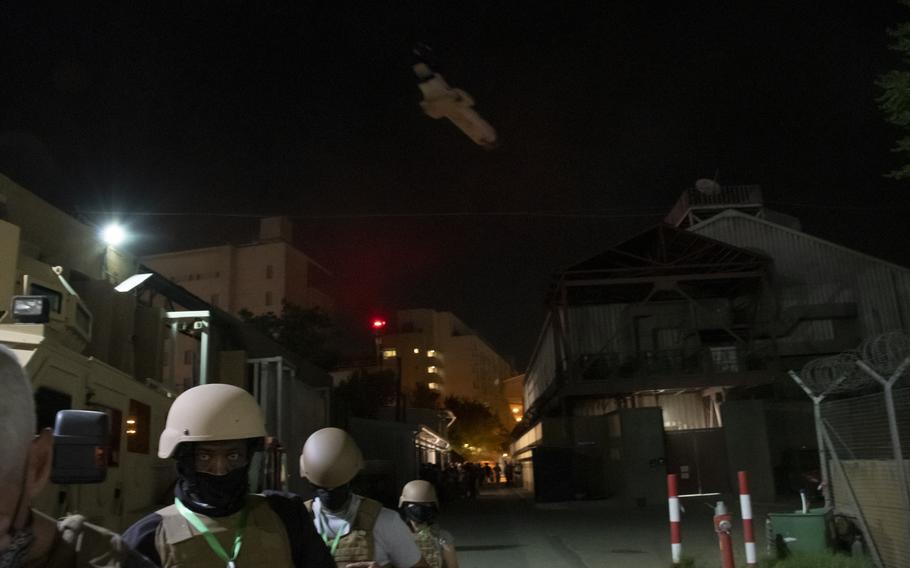
Staff evacuate the U.S. Embassy in Kabul shortly after midnight on Sunday, Aug. 15, 2021. (Phillip Walter Wellman/Stars and Stripes)
U.S. airstrikes against the Taliban surged in August, rising to levels not seen in nearly a year as part of the final, failed attempt to prevent the Afghan army’s collapse as militants rapidly took over the country, according to data disclosed Friday.
The burst of attacks came as Taliban fighters encircled numerous provincial capitals and ultimately seized control of Kabul, Afghanistan’s capital, on Aug. 15. About 153 U.S. bombs or missiles were dropped by U.S. war planes and drones that month, up from 18 in July, the data showed.
Until Friday, the U.S. Air Force had not released such a report for nearly two years.
The data does not include strikes launched by the Afghan air force, which routinely carried out bombing until disbanding along with the central government. Nonetheless, the numbers offer a fresh look at how the American military scrambled in the waning days of its longest war, as the situation on the ground grew increasingly desperate for U.S.-trained Afghan forces being overpowered by the Taliban’s assault.
For many years, the U.S. Air Force released “air power summaries” monthly in a demonstration of transparency to American taxpayers, congressional oversight committees and U.S. allies. But publication was suspended after the Trump administration signed a deal with the Taliban in February 2020 that promised to withdraw U.S. troops by this year in exchange for a handful of concessions, including that militants stop attacking U.S. troops. U.S. forces remaining in Afghanistan would retain the ability to defend themselves, U.S. officials said, but they continued to carry out limited airstrikes in support of their Afghan allies.
Pentagon spokesman John Kirby said Friday before the reports’ distribution that Defense Secretary Lloyd Austin directed that the data again be released in an effort to improve transparency. The withheld monthly reports date back to February 2020, he said.
Kirby said there have been no U.S. military airstrikes in Afghanistan since the withdrawal was completed Aug. 30. The Pentagon will continue to provide air power summaries, he said, with publication by Air Forces Central Command, which oversees operations in the region.
The airstrikes occurred as hundreds of civilians were killed per month in 2021, mostly in roadside bomb explosions or fighting between Afghan forces and the Taliban, according to U.N. mission reports. The U.S. military did kill some civilians, however, including in an Aug. 28 strike in Kabul in which commanders thought they were striking an Islamic State bomber but killed an aid worker and nine other civilians.
At the height of its air campaign against the Taliban, the U.S. military conducted thousands of strikes annually, reaching a high of 7,423 in 2019, as commanders attempted to force the Taliban to negotiate an end to the war.
The bombing campaign remained busy early in 2020, with 415 weapons dropped in January and 360 in February of last year. But it plummeted after the withdrawal deal was signed, with 116 weapons dropped in March, 27 in April, 15 in May and 18 that June, the newly released data show.
The numbers climbed again from there, as the Taliban mostly held true to not attacking U.S. troops but waged a bloody campaign against Afghan police and soldiers. The U.S. military dropped 246 weapons in October 2020, and then more than 100 per month for the first third of 2021, the reports show. The numbers tailed off again beginning in May, before the last spike as the Taliban asserted control of the country.